Abstract
The objective of this study was to determine whether hyperoxia enhances aminoglycoside activity against Pseudomonas aeruginosa. The existence of tobramycin-oxygen synergy was determined by using the in vitro postantibiotic effect (PAE). P. aeruginosa strains were incubated for 1 h in medium containing tobramycin at four times the MIC in the following gas mixtures: normoxia (21% O2), hyperoxia (100% O2, 101.3 kPa), or hyperbaric oxygen (100% O2, 274.5 kPa). Tobramycin was removed after 1 h and bacteria were incubated under normoxic conditions; growth rates were measured for 5 h. Exposure of three P. aeruginosa strains to hyperoxia prolonged the PAE of tobramycin approximately twofold compared with the PAE after exposure to normoxia (P less than 0.05). Exposure of P. aeruginosa ATCC 27853 to tobramycin and hyperbaric oxygen prolonged the time required for bacteria to increase 1 log10 CFU/ml compared with the time after exposure for this increase to occur in tobramycin-treated, normoxic or hyperoxic groups (P less than 0.02). Pulse-chase labeling of bacteria with L-[35S]methionine, immediately after removal of tobramycin, showed that protein synthesis rates were decreased compared with those in controls (P = 0.0001). Moreover, in tobramycin-treated groups, hyperoxia and hyperbaric oxygen induced 2- and 16-fold decreases, respectively, in protein synthesis rates compared with normoxia; these results did not achieve statistical significance. In the absence of tobramycin, hyperoxia increased bacterial growth (134%; P less than 0.01) and protein synthesis (24%; not significant) compared with normoxia. Hyperbaric oxygen, however, delayed the growth recovery of bacteria (P less than 0.05). We conclude that hyperoxia enhances the bacteriostatic effects of tobramycin in a synergistic manner.+
Full text
PDF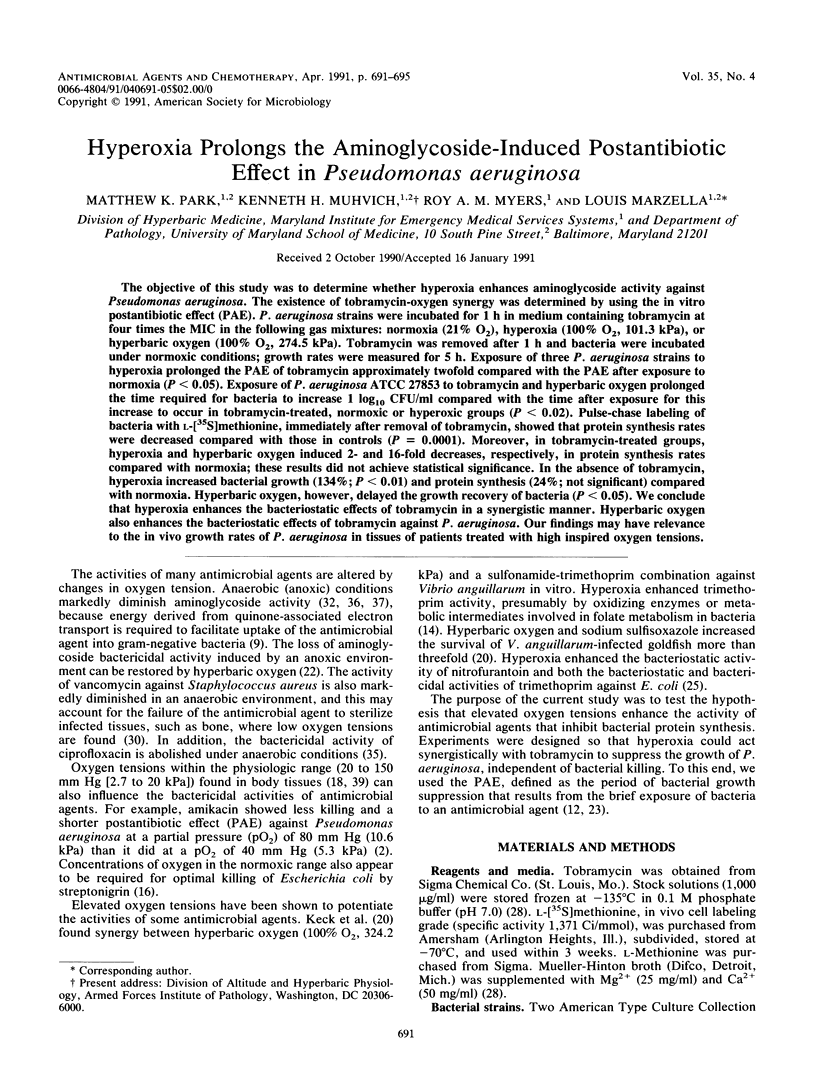
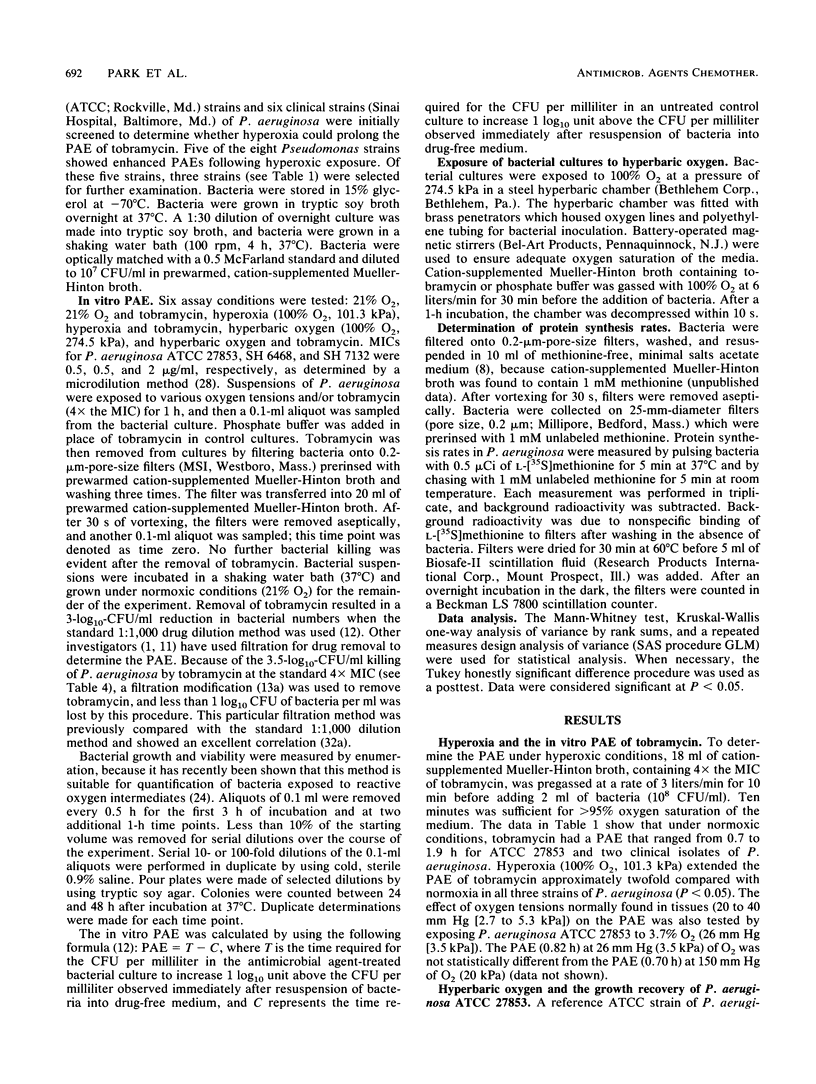
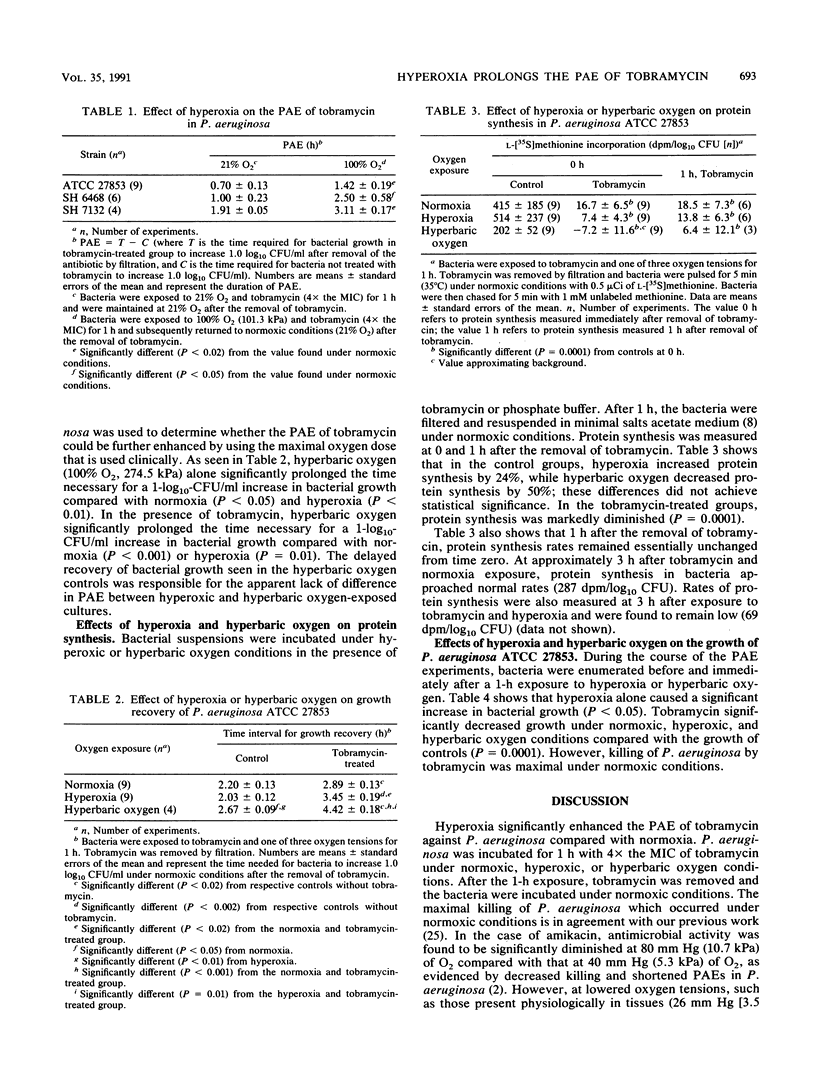
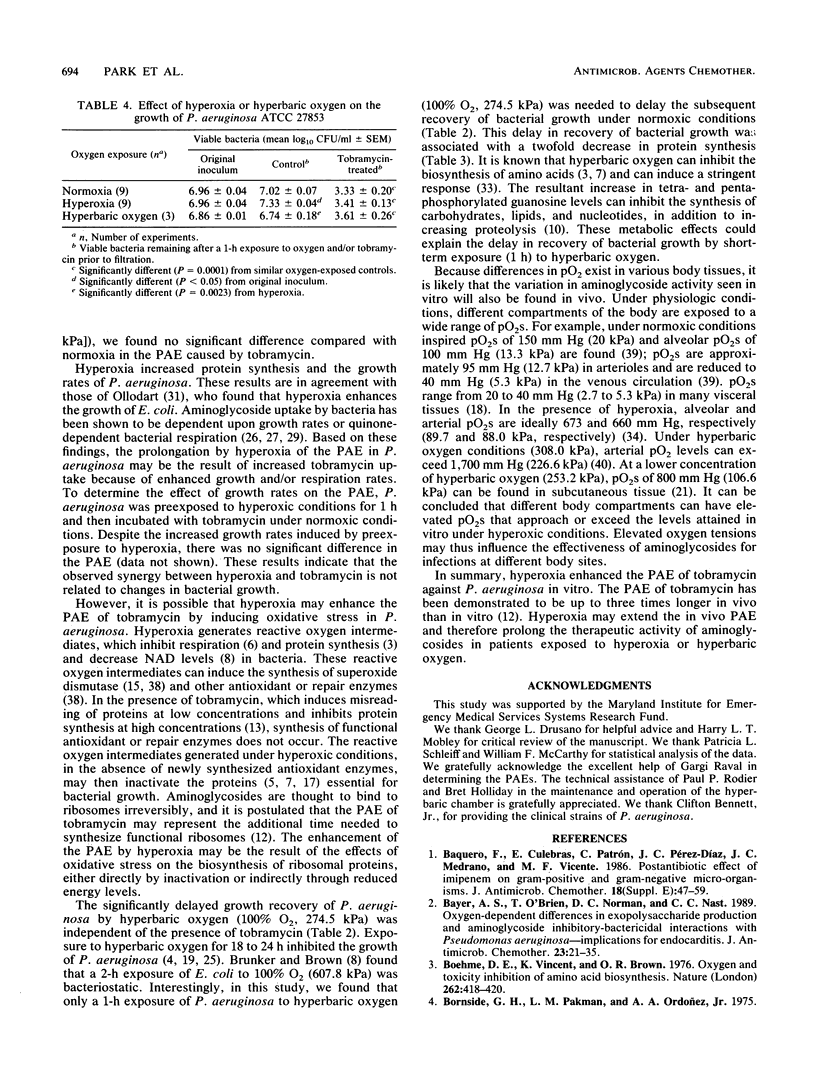
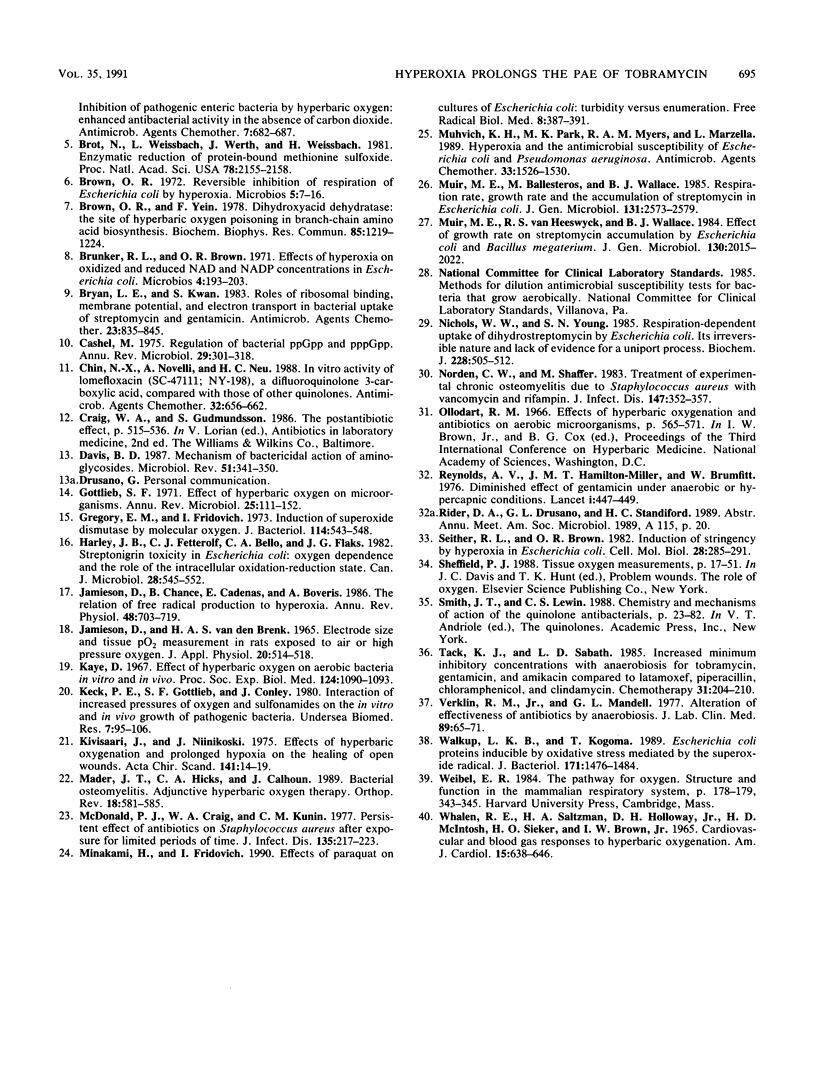
Selected References
These references are in PubMed. This may not be the complete list of references from this article.
- Baquero F., Culebras E., Patrón C., Pérez-Díaz J. C., Medrano J. C., Vicente M. F. Postantibiotic effect of imipenem on gram-positive and gram-negative micro-organisms. J Antimicrob Chemother. 1986 Dec;18 (Suppl E):47–59. doi: 10.1093/jac/18.supplement_e.47. [DOI] [PubMed] [Google Scholar]
- Bayer A. S., O'Brien T., Norman D. C., Nast C. C. Oxygen-dependent differences in exopolysaccharide production and aminoglycoside inhibitory-bactericidal interactions with Pseudomonas aeruginosa--implications for endocarditis. J Antimicrob Chemother. 1989 Jan;23(1):21–35. doi: 10.1093/jac/23.1.21. [DOI] [PubMed] [Google Scholar]
- Boehm D. E., Vincent K., Brown O. R. Oxygen and toxicity inhibition of amino acid biosynthesis. Nature. 1976 Jul 29;262(5567):418–420. doi: 10.1038/262418a0. [DOI] [PubMed] [Google Scholar]
- Bornside G. H., Pakman L. M., Ordóez A. A., Jr Inhibition of pathogenic enteric bacteria by hyperbaric oxygen: enhanced antibacterial activity in the absence of carbon dioxide. Antimicrob Agents Chemother. 1975 May;7(5):682–687. doi: 10.1128/aac.7.5.682. [DOI] [PMC free article] [PubMed] [Google Scholar]
- Brot N., Weissbach L., Werth J., Weissbach H. Enzymatic reduction of protein-bound methionine sulfoxide. Proc Natl Acad Sci U S A. 1981 Apr;78(4):2155–2158. doi: 10.1073/pnas.78.4.2155. [DOI] [PMC free article] [PubMed] [Google Scholar]
- Brown O. R. Reversible inhibition of respiration of Escherichia coli by hyperoxia. Microbios. 1972 Jan;5(17):7–16. [PubMed] [Google Scholar]
- Brown O. R., Yein F. Dihydroxyacid dehydratase: the site of hyperbaric oxygen poisoning in branch-chain amino acid biosynthesis. Biochem Biophys Res Commun. 1978 Dec 14;85(3):1219–1224. doi: 10.1016/0006-291x(78)90672-1. [DOI] [PubMed] [Google Scholar]
- Brunker R. L., Brown O. R. Effects of hyperoxia on oxidized and reduced NAD and NADP concentrations in Escherichia coli. Microbios. 1971 Dec;4(15):193–203. [PubMed] [Google Scholar]
- Bryan L. E., Kwan S. Roles of ribosomal binding, membrane potential, and electron transport in bacterial uptake of streptomycin and gentamicin. Antimicrob Agents Chemother. 1983 Jun;23(6):835–845. doi: 10.1128/aac.23.6.835. [DOI] [PMC free article] [PubMed] [Google Scholar]
- Cashel M. Regulation of bacterial ppGpp and pppGpp. Annu Rev Microbiol. 1975;29:301–318. doi: 10.1146/annurev.mi.29.100175.001505. [DOI] [PubMed] [Google Scholar]
- Chin N. X., Novelli A., Neu H. C. In vitro activity of lomefloxacin (SC-47111; NY-198), a difluoroquinolone 3-carboxylic acid, compared with those of other quinolones. Antimicrob Agents Chemother. 1988 May;32(5):656–662. doi: 10.1128/aac.32.5.656. [DOI] [PMC free article] [PubMed] [Google Scholar]
- Davis B. D. Mechanism of bactericidal action of aminoglycosides. Microbiol Rev. 1987 Sep;51(3):341–350. doi: 10.1128/mr.51.3.341-350.1987. [DOI] [PMC free article] [PubMed] [Google Scholar]
- Gottlieb S. F. Effect of hyperbaric oxygen on microorganisms. Annu Rev Microbiol. 1971;25:111–152. doi: 10.1146/annurev.mi.25.100171.000551. [DOI] [PubMed] [Google Scholar]
- Gregory E. M., Fridovich I. Induction of superoxide dismutase by molecular oxygen. J Bacteriol. 1973 May;114(2):543–548. doi: 10.1128/jb.114.2.543-548.1973. [DOI] [PMC free article] [PubMed] [Google Scholar]
- Harley J. B., Fetterolf C. J., Bello C. A., Flaks J. G. Streptonigrin toxicity in Escherichia coli: oxygen dependence and the role of the intracellular oxidation--reduction state. Can J Microbiol. 1982 May;28(5):545–552. doi: 10.1139/m82-082. [DOI] [PubMed] [Google Scholar]
- Jamieson D., Chance B., Cadenas E., Boveris A. The relation of free radical production to hyperoxia. Annu Rev Physiol. 1986;48:703–719. doi: 10.1146/annurev.ph.48.030186.003415. [DOI] [PubMed] [Google Scholar]
- Jamieson D., van den Brenk H. A. Electrode size and tissue pO2 measurement in rats exposed to air or high pressure oxygen. J Appl Physiol. 1965 May;20(3):514–518. doi: 10.1152/jappl.1965.20.3.514. [DOI] [PubMed] [Google Scholar]
- Kaye D. Effect of hyperbaric oxygen on aerobic bacteria in vitro and in vivo. Proc Soc Exp Biol Med. 1967 Apr;124(4):1090–1093. doi: 10.3181/00379727-124-31932. [DOI] [PubMed] [Google Scholar]
- Keck P. E., Gottlieb S. F., Conley J. Interaction of increased pressures of oxygen and sulfonamides on the in vitro and in vivo growth of pathogenic bacteria. Undersea Biomed Res. 1980 Jun;7(2):95–106. [PubMed] [Google Scholar]
- Kivisaari J., Niinikoski J. Effects of hyperbaric oxygenation and prolonged hypoxia on the healing of open wounds. Acta Chir Scand. 1975;141(1):14–19. [PubMed] [Google Scholar]
- Mader J. T., Hicks C. A., Calhoun J. Bacterial osteomyelitis. Adjunctive hyperbaric oxygen therapy. Orthop Rev. 1989 May;18(5):581–585. [PubMed] [Google Scholar]
- McDonald P. J., Craig W. A., Kunin C. M. Persistent effect of antibiotics on Staphylococcus aureus after exposure for limited periods of time. J Infect Dis. 1977 Feb;135(2):217–223. doi: 10.1093/infdis/135.2.217. [DOI] [PubMed] [Google Scholar]
- Minakami H., Fridovich I. Effects of paraquat on cultures of Escherichia coli: turbidity versus enumeration. Free Radic Biol Med. 1990;8(4):387–391. doi: 10.1016/0891-5849(90)90105-r. [DOI] [PubMed] [Google Scholar]
- Muhvich K. H., Park M. K., Myers R. A., Marzella L. Hyperoxia and the antimicrobial susceptibility of Escherichia coli and Pseudomonas aeruginosa. Antimicrob Agents Chemother. 1989 Sep;33(9):1526–1530. doi: 10.1128/aac.33.9.1526. [DOI] [PMC free article] [PubMed] [Google Scholar]
- Muir M. E., Ballesteros M., Wallace B. J. Respiration rate, growth rate and the accumulation of streptomycin in Escherichia coli. J Gen Microbiol. 1985 Oct;131(10):2573–2579. doi: 10.1099/00221287-131-10-2573. [DOI] [PubMed] [Google Scholar]
- Muir M. E., van Heeswyck R. S., Wallace B. J. Effect of growth rate on streptomycin accumulation by Escherichia coli and Bacillus megaterium. J Gen Microbiol. 1984 Aug;130(8):2015–2022. doi: 10.1099/00221287-130-8-2015. [DOI] [PubMed] [Google Scholar]
- Nichols W. W., Young S. N. Respiration-dependent uptake of dihydrostreptomycin by Escherichia coli. Its irreversible nature and lack of evidence for a uniport process. Biochem J. 1985 Jun 1;228(2):505–512. doi: 10.1042/bj2280505. [DOI] [PMC free article] [PubMed] [Google Scholar]
- Norden C. W., Shaffer M. Treatment of experimental chronic osteomyelitis due to staphylococcus aureus with vancomycin and rifampin. J Infect Dis. 1983 Feb;147(2):352–357. doi: 10.1093/infdis/147.2.352. [DOI] [PubMed] [Google Scholar]
- Reynolds A. V., Hamilton-Miller J. M., Brumfitt W. Diminished effect of gentamicin under anaerobic or hypercapnic conditions. Lancet. 1976 Feb 28;1(7957):447–449. doi: 10.1016/s0140-6736(76)91474-4. [DOI] [PubMed] [Google Scholar]
- Seither R. L., Brown O. R. Induction of stringency by hyperoxia in Escherichia coli. Cell Mol Biol. 1982;28(3):285–291. [PubMed] [Google Scholar]
- Tack K. J., Sabath L. D. Increased minimum inhibitory concentrations with anaerobiasis for tobramycin, gentamicin, and amikacin, compared to latamoxef, piperacillin, chloramphenicol, and clindamycin. Chemotherapy. 1985;31(3):204–210. doi: 10.1159/000238337. [DOI] [PubMed] [Google Scholar]
- Verklin R. M., Jr, Mandell G. L. Alteration of effectiveness of antibiotics by anaerobiosis. J Lab Clin Med. 1977 Jan;89(1):65–71. [PubMed] [Google Scholar]
- WHALEN R. E., SALTZMAN H. A., HOLLOWAY D. H., Jr, MCINTOSH H. D., SIEKER H. O., BROWN I. W., Jr CARDIOVASCULAR AND BLOOD GAS RESPONSES TO HYPERBARIC OXYGENATION. Am J Cardiol. 1965 May;15:638–646. doi: 10.1016/0002-9149(65)90350-4. [DOI] [PubMed] [Google Scholar]
- Walkup L. K., Kogoma T. Escherichia coli proteins inducible by oxidative stress mediated by the superoxide radical. J Bacteriol. 1989 Mar;171(3):1476–1484. doi: 10.1128/jb.171.3.1476-1484.1989. [DOI] [PMC free article] [PubMed] [Google Scholar]


